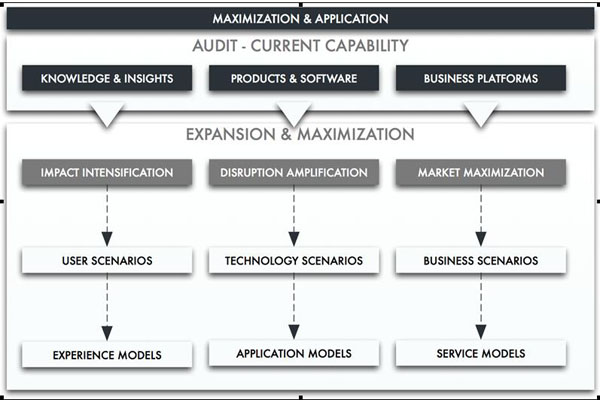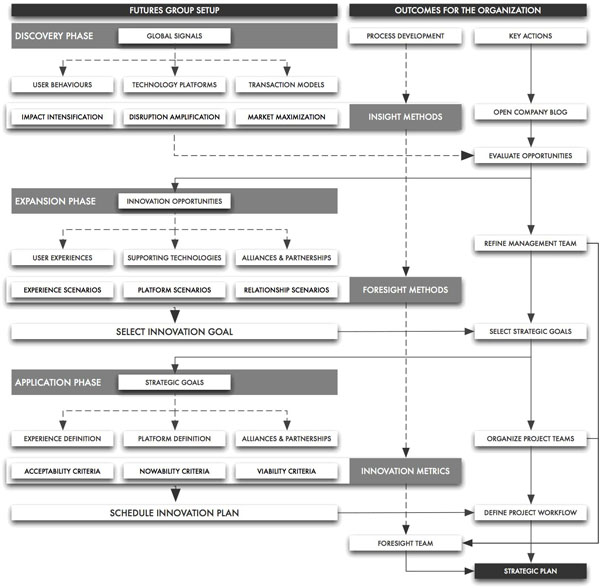
Creating ‘Places of Possibility’
Places of Possibility are free of the day-to-day metrics of the traditional organization -- and the word ‘free’ is of particular importance here
For organizations seeking growth through value creation, the challenge at hand is to create cultures in which platforms for the exploration of possibility are both encouraged and enabled. Unleashing such an innovative mindset is about creating a culture that empowers inquisitive minds to imagine the future, and to think beyond the legacy of the past.
I call these ‘Places of Possibility’, and they look quite different from traditional organizations: both lean and nimble, they embrace risks, partner with spectacularly-different competencies than the obvious, and prototype fast, fail fast and fail cheap. These are places where everyone feels empowered to explore and share ideas, with no fear of consequences.
Places of Possibility are free of the day-to-day metrics of the traditional organization -- and the word ‘free’ is of particular importance here. The exercise of freedom is quite different from freedom as a concept, and I believe that this semantic difference will present major challenges for innovation-seeking organizations in coming years. In particular, the challenge relates to issues of human resources.
Organizations face a significant HR challenge at both ends of the generation spectrum: for the Baby Boomers in senior management, the question is “how can we attract and retain ‘Millennials’ (the generation born after 1980) and how can we empower them to make significant contributions in the competitive landscape of our mobile society?” To answer these questions, we first need to understand the typology of this social and cultural group, and their expectations.
Raised to believe that ‘everything is possible’ and ‘the sky is the limit’, the Millennials are people of ambition, purpose and experimentation. They have grown up in an environment in which technology allowed them early participation in culture, as well as hands on experience in the creation of a new network society in which they feel they are in control.
Millennials grew up in a time in which the conceptual mythology and its characters became part of everyday play life: Star Wars characters and situations became quickly-perceptual objects that further released their imagination while they engaged in play. The same can be said about Ninja Turtles, Voltron and in the 1990’s, the world of Toy Story. The immediacy of culture allowed for a rapid transfer of the imagination from thought to action, and as a result, these are action-orientated people who concern themselves little with the analysis of situations in terms of metrics – “is it needed? Will it bring significant revenue?” – believing instead that what they like, others like them will like as well.
Google, Facebook, MySpace and Wikipedia are manifestations of this belief system. They are also manifestations of the return of play, and the freedom associated with it, to the life of the adult.
These individuals often face disappointment when they join the workforce, because the Baby Boomer (‘analogue generation’) and the Millennials (‘digital generation’) are not just separated by age: they are separated by experience and expectations. For Millennials, empowerment is a condition sine qua non, and as such, it is also an expectation. With empowerment, the Millennial has learned about participation in the shaping of culture and society and with that, they have learned that one can – in a satisfying way – operate from a condition of freedom. For the Millennial, freedom is not a concept, it is an experienced percept.
Having been promised all the freedom of thought and action worthy of their generations’ aspiration, they join an organization only to discover that the structures of the workplace are not as open to change as they claim to be. They join a system that does not necessarily recognize imagination, play and the cultural and economic participation that has characterized their behaviour up to that point. Complicating matters, the age-old structure of the organization does not see the empowerment and participation of the Millennials as necessary to its prosperity. In such an environment, young workers often become stifled in their work and slowly disempowered.
Facebook as a ‘need’ will never make sense to a Baby Boomer, and even less so as a revenue platform for business. But that is not what Facebook is all about; it is more than that -- it is culture. And Millennials know about the creation of culture because they grew up being a part of it at every step. In as much as the Millennial is an empowered individual who acts on this empowerment by participating actively in the shaping of his own world, the Baby Boomer was empowered in thought but not in action: the Boomers never lived up to the promise of their generation and worse still, largely succumbed to the rules of the status quo.
Ironically, Baby Boomer managers were also part of a generation that once felt everything was possible; the difference is, while they achieved a certain degree of transformation in society, they failed to challenge the very nature and structure of ‘work’ itsef. Rather than changing it, they figured out how to make the status quo work for them.
The key to understanding the gap between these two generations is this: the Millennial wants to have fun as a life attribute, while the Baby Boomer has fun as entertainment -- programmed fun, within time limits and specific formats and places. This is why YouTube makes no sense to a Baby Boomer, and even less so, blogging or texting.
For the Millennial, words are not confused with actions. They seek to transform feelings into reality, and they have the means, the desire and the will to do it. What is a dream for the Baby Boomer is seen as a right for the Millennial. And at times, due to these vastly different attitudes, the two groups cannot hear each other, let alone begin to understand each other.
The digital generation instinctively ‘gets it’ when it comes to technology, taking purpose for granted. The Millennial will never ask, “Who will use this?” or “What is the purpose of this?” as they do not concern themselves with such questions. For them, the purpose is a continuum of life; it is as obvious as breathing. At the other end of the cultural and expectation spectrum, for the analogue, every object, service or new technology must have a purpose rooted in ‘need’. “Who needs this?” is a question frequently asked by this group in an effort to measure change by their own ability to comprehend where new devices and services might fit, in the prescribed framework of what life ‘should’ be about.
With the analogue generation still in control of the organization and the digital generation performing the daily work, clashes are imminent and inevitable. Even when they come face to face, the dialogue is often between the deaf and the mute, as there is no common experience that unifies the two groups and enables a constructive dialogue.
This is why we need a new platform for communication, collaboration and dialogue. On one hand you have the wisdom, knowledge and life experience of the Boomer, and on the other you have the urgency, the imagination and the free spirit of the Millennial. Imagine the possibilities for the organization if these two capabilities were combined? One imparting method while the other imparting experimentation and courage?
To get started in creating such a Place of Possibility, I propose that organizations empower a group of their most talented resources from the analogue and digital generations to form what I will call a ‘Futures Group’. The group’s task will be to identify significant strategic shifts at their early stages; and to describe the potential of these strategic shiftsbefore they can be measured. The rules are simple: each member of the group expands on the potential of their imagination, supports their colleagues to do the same, enhancing the competitiveness, innovativeness and potential of the organization.
The Futures Group can become a Place of Possibility that does not concern itself too much with the all the things we cannot do; instead, it always asks: What CAN WE DO –what shall de do – and what do we want to do?
A purpose statement for a Futures Group might look something like this:
1. To guide participants into a renewed way of looking at the business, and the world it works in;
2. To unify the experience and aspirations of all groups in the organization, by providing for a common platform of experience and competence;
3. To experience how to manage the design process toward innovative breakthrough ideas into products, services and experiences;
4. To change the participants’ outlook from reacting to technological or behavioural disruptions, to the proactive exploration of the beneficial innovation possibilities for goods and services;
5. To discover and/or unveil existing, but still invisible, potential market areas and means of operations; and
6. To integrate, unleash and accelerate the sensitivity, imagination and capability of innovativeness into the core business functions of the organization.
Figure One: The Futures Group: A Strategic Innovation Planogram

Members of the group would have to agree to the following terms:
• We understand that our consumers are expecting new forms of engagement with our brand.
• We recognize that we need to become experts in understanding value, and also in understanding where value resides.
• We recognize that digital media in all its emergent forms represents a new form of engagement with life, and we are committed to deliver vitality to this new space.
• We recognize the need to engage in new ways, building better and more expansive relationships with our users, on multiple platforms of experience and on the user’s chosen terms.
• We are determined to develop the ability to move swiftly from one platform to the next, and from one compelling experience to another.
• We understand that brands are not about lifestyle, but about life choices: the choice to live healthy, the choice to eat well. These choices transcend lifestyle and are the voice of expectations; expectations now include people’s participation in the shaping of their daily life, and access to new tools of empowerment and new media for expressions of this participation.
• To add value to this new way of life, the Futures Group will provide the tools and inspirations for engagement and participation; we will construct new platforms of experience and engage our users as participatory individuals.
• In summary, our vision is to be part of the user’s multidimensional expectations of themselves and their life.
By taking the required steps to embrace the challenge of enabling your analogue and digital generations to communicate better, you will be well on the road to creating a Place of Possibility in your organization. Just imagine the new worlds that are waiting to be discovered.
Alexander Manu is an adjunct professor at the Rotman School of Management, where he teaches a second-year MBA course called “Innovation, Foresight and Business Design.” He is also a professor at the Ontario College of Art and Design University and the author of Disruptive Business: Desire, Innovation and the Redesign of Business (Gower, 2010).
Figure Two: Futures Group Stages

[This article has been reprinted, with permission, from Rotman Management, the magazine of the University of Toronto's Rotman School of Management]





